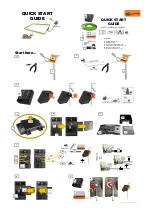
19/76
MP120
•
Buzzer
: it reproduces the keyboard buzzer signals in real time, and is used to reproduce such signals through
other devices or remotely. For instance, you may connect a more powerful sound device than the buzzer to hear
the sound even in very noisy places. WARNING! Considering that transmission on the bus may generate slight
delays, correct transfer of quick signals (e.g. confirmation beeps) to the outputs controlled by remote
expansions will not be guaranteed.
•
Sector TC
: it is used to enable detectors and sirens. Its actuation is conditioned by the AND and OR operators
for the sectors correlated to the output. The output will surely be at rest if all the correlated sectors are OFF. If
its level is inverted, this output may be used to signal the system status, without the piece of information being
conditioned by the memory, as is the case with the output of the “System status” type. WARNING! Output 3 is
factory-set as an “Sector OR” type output, whereas output 4 is factory-set as a “Sector AND” type output.
USING THE TC OUTPUT
Below are two examples of how to use the TC output, assuming that a high-power siren is to be controlled.
Example 1. Company including office and warehouse spaces
: by correlating the offices and warehouses
to different sectors, you will be allowed to actuate them separately. In this case, by using an OR TC output, the
controlled siren will ring every time an attempt at break-in is made in an actuated sector, regardless of whether
the other sector is ON.
Example 2. House & garage
: by correlating the house and the garage to different sectors, you will be allowed
to actuate them separately. In this case, by using an AND TC output if the garage is actuated and the house is
not (e.g. people are sleeping inside the house) and an attempt at break-in is made in the garage, the
controlled siren will not ring (the attempt at break-in may in any case be signalled by connecting another
sound device to a properly configured output). The controlled siren will be enabled only when both sectors are
ON (no people present).
AND and OR logic functions
The AND operator assumes that all the terms (in this case, the sectors) of the operation are true (in this case,
active) in order for the result to be true (output alarm status).
As far as the OR operator is concerned, on the contrary, it is enough that at least one of the terms is true (i.e.
active) in order for the result to be true (output alarm status).
The exemplifying table below may help you better understand this.
Sector status
Output status
Sector 1
Sector 2
Sector 3
con AND
con OR
OFF
OFF
OFF
At rest
At rest
OFF
OFF
ON
At rest
Alarm
ON
OFF
ON
At rest
Alarm
ON
ON
ON
Alarm
Alarm
•
System status
: it signals whether the correlated sectors are ON or OFF and whether stored alarms are
available. Signals are provided by properly changing the output status, as illustrated in the diagram below.
System OFF
System ON
System OFF with alarms
stored
System ON with alarms
stored
•
Open input (OI)
: it is actuated every time an input of the system is opened.
•
LPA
: it is actuated every time any of the alarm signals belonging to the LPA configuration is emitted. Thus, one
same output may respond to several types of alarm. Up to 8 signals may be assigned to the LPA configuration,
which will be controlled by all the outputs programmed as LPA. The alarm events that can be correlated are:
1 – Break-in
2 – Tampering
3 – Robbery
4 – Panic
5 – Technological
6 – Fire
7 – Failure
8 – Chime
•
IN −> OUT
: the output follows the status of the corresponding input (open input = output ON; closed input =
output at rest). You need not program the input: you just need to specialize the output. The inputs and outputs
make up fixed pairs, which cannot be modified. These pairs are as follows:
















































